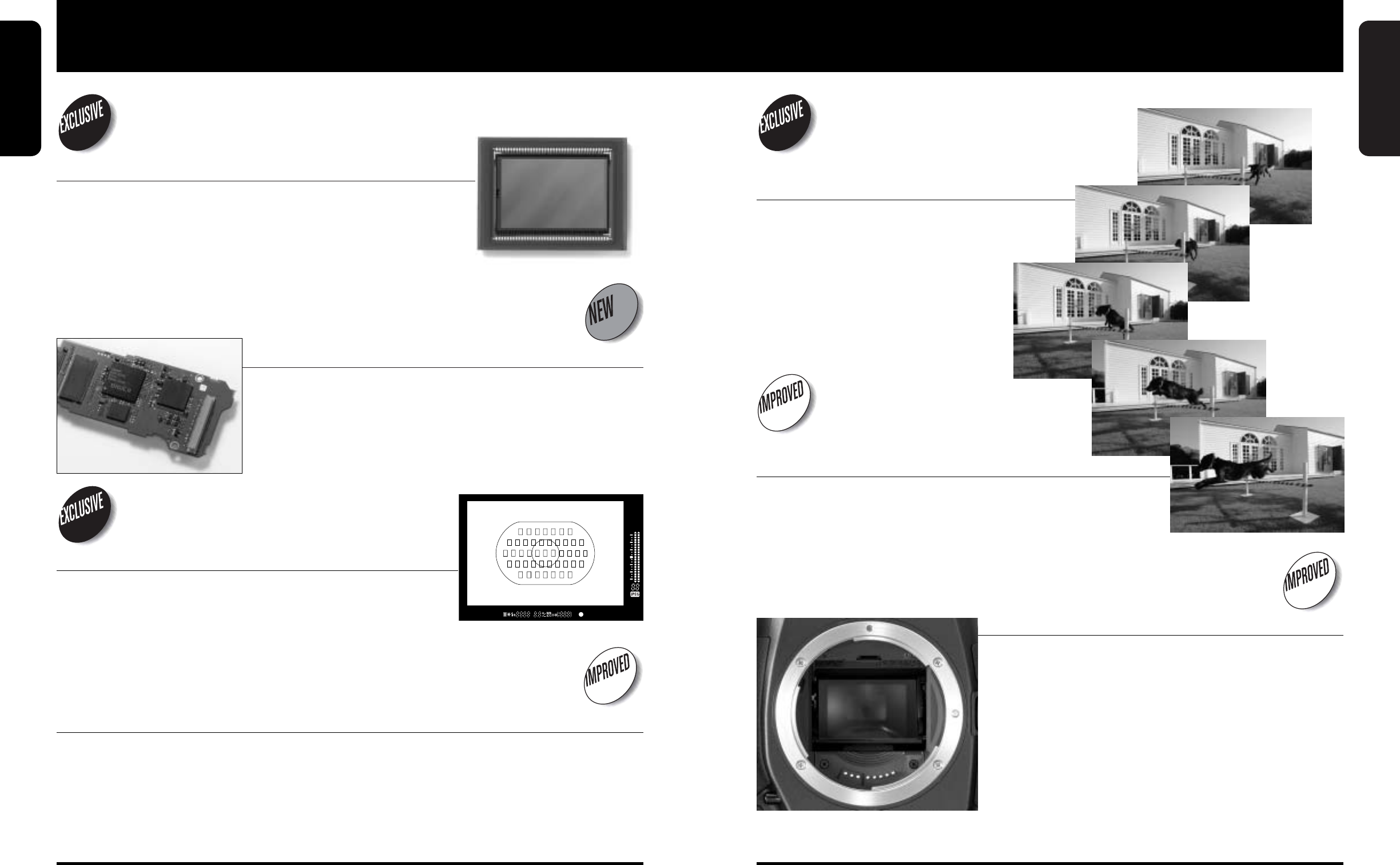
HEADLINE
OVERVIEW
OVERVIEW
OVERVIEW 5
A NEW LEVEL OF HIGH PERFORMANCE
NEW 8.2 MEGAPIXEL CMOS SENSOR
The heart of the EOS-1D Mark II’s stunning image quality is its all-new, Canon designed
and manufactured, CMOS sensor. Canon has doubled the resolution of the EOS-1D with
more than 8 million large pixels on a chip that measures 28.7 x 19.1mm. There is
enough resolution to satisfy professional wedding, portrait, fashion, nature and industrial
photographers – amazing in a camera fast enough to be the sports shooter’s first choice.
The lens magnification factor is only 1.3x, so your wide-angle lenses are still wide.
The large pixels mean more sensitivity to light, higher effective ISOs, better shadow
and highlight detail, less amplification required and much less noise. And CMOS means
significantly less power consumption and longer battery life than CCD.
NEW ≥II IMAGING PROCESSOR
The amazing new DIGIC II Imaging Processor is one of the key components to the
EOS-1D Mark II’s landmark performance. It places all signal processing on a single
board and it employs the world’s first DDR-SDRAM (Double Data Rate Synchronous
Dynamic Random Access Memory) in a digital camera for ultra-high speed and
reliability. It reads image sensor data from 8 channels simultaneously for blazing
speed combined with enormous file-handling capabilities. The DIGIC II provides
superb color accuracy, wide tonal range, and exceptional detail, all with low noise
and even lower power consumption.
4 OVERVIEW
HIGH-PRECISION 45-POINT AREA AF
The EOS-1D Mark II uses the same legendary 45-point Area AF focusing sensor as the
EOS-1v, -1D and -1Ds cameras. The 45 focusing points are densely packed and can
be manually or automatically selected to meet the needs of any situation. AF speed
and performance is better than ever in the EOS-1D Mark II, with significantly faster
processing of AF information in-camera. Whereas earlier models used a single CPU to
control AF as well as other operations, the Mark II uses a new dual-CPU system that
boosts AF speed and precision.
ELIMINATION OF LONG EXPOSURE NOISE
The longer a digital imaging sensor is exposed to light, the greater the likelihood that it will generate digital “noise,” similar to “snow”
on a TV with poor reception. In the EOS-1D Mark II, there is less inherent noise in the system to begin with because of revised on-chip
noise reduction circuitry and the DIGIC II Imaging Processor. For longer exposures, the camera cuts off driving and output current,
and starting at 1 second, Dark Frame Subtraction is optionally available, removing any remaining noise. The result is a digital camera
that yields long-exposure images that were previously the domain of film. This is yet another way in which the EOS-1D Mark II is
the complete professional camera.
FAST, ACCURATE AF
FOREVERY SITUATION
The EOS-1D Mark II's new AF circuitry provides faster
performance than ever in both One-Shot AF and AI
Servo AF. Compared to the EOS-1D, read-and-react
times are quicker, and the number of AF readings
between shots in an AI Servo AF sequence has been
doubled for superior focus-tracking precision.
Predictive AF control now works effectively even
for single shots or the first shot of a sequence
in AI Servo AF.
FULL RESOLUTION 8.5 FPS
WITH A 40-SHOT BURST
The world’s fastest* Digital SLR, the EOS-1D Mark II has the ability to shoot 8.5 fps
for up to 40 JPEG or 20 RAW consecutive frames at the maximum resolution of 8.2
megapixels, thanks to a new 8-channel readout from the CMOS sensor together with
the high-speed DDR-SDRAM used for buffer memory. The camera's CF card interface
now transfers data at speeds up to 5.0MB per second, 50% faster than the EOS-1D.
*Among digital SLR cameras as of February 2004 (based on Canon survey)
ACTIVE MIRROR CONTROL
During continuous high-speed shooting, mirror blackout time
becomes a serious problem. The faster the mirror comes down
and stabilizes, the clearer, sharper and brighter the finder image is.
The EOS-1D Mark II shares with the EOS-1v, -1D and -1Ds a Canon
innovation called Active Mirror Control which replaces conventional
suppression of mirror rebound shock with a mechanical system
which incorporates a hook on the backside of the main mirror.
The hook holds the mirror in place when it flips down, reducing
mirror bounce and shake and confining it to a much shorter duration.
In addition to reducing blackout time to a mere 87ms, the finder
image stabilizes faster, giving a much more accurate and less
fatiguing view and giving the predictive AF more time to do its job.














